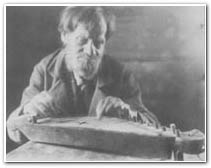|

Jaakko Kulju from
the village of Parkinselkä in Suojärvi, photographed
in 1917 playing a 9-string kantele. Kulju also played a larger
16-string kantele, during which he moved his fingers from one
string to the next. Photo by A.O. Väisänen, Museovirasto/National
Board of Antiquities.
|
Jaakko
Kulju: An Old Master
"The
player's fingers [touched] the strings according to the tune,
but his eyes [did not] follow the activity, gazing blankly at
the air in front of him. As the old man from Suojärvi continued
to play his endless 'summer hymn' I took a photograph, exposing
the frame for a rather long time, and marveled at how he did not
blink at all, nor pay any attention to my photography whatsoever.
He had lapsed into his world of quiet strumming. Gradually, as
the same tune continued with most subtle of variations, his body
began to slump against the table, his eyelids closed, the old
man played as if in his sleep. Although I listened with the ear
of a seasoned observer, I felt myself being cast under a spell.
After this experience I was easily able to believe Old Man Onoila
when he told me of one Karelian man who played so sadly that he
made his listeners cry, and so joyfully that he made them dance...."
Excerpted
from A.O. Väisänen's article "Song and Instrument-Playing
in Folk Culture", published in Musiikkitieto, November 1943.
(translated from Finnish by Heli Tuomi)
|




